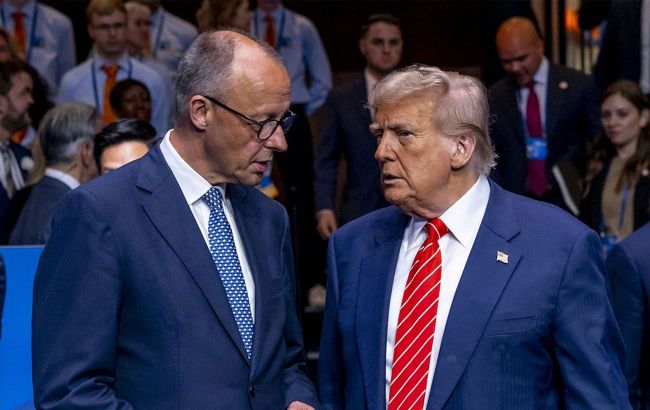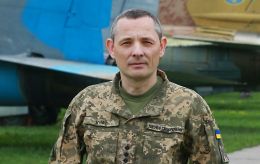Trump's 5% challenge. How Europe reacts to ultimatum and what it means for Ukraine
 German Chancellor Friedrich Merz and US President Donald Trump at the NATO summit in The Hague (Photo: nato.int)
German Chancellor Friedrich Merz and US President Donald Trump at the NATO summit in The Hague (Photo: nato.int)
How European leaders sat an exam in front of Donald Trump at the NATO summit and why Europe struggles to push itself to spend more on defense - read in the column by RBC-Ukraine's deputy editor-in-chief, Milan Lelich.
Key questions:
- How did European leaders flatter Donald Trump before the NATO summit?
- Who among the Europeans tried to avoid raising defense spending, and what was the outcome?
- How does Italy want to include the construction of a bridge in its military budget?
- What influences Europeans’ perception of Russia as a direct threat?
Last week, European leaders breathed a big sigh of relief. The NATO summit — Donald Trump's first meeting with the European establishment in such a broad format — not only didn't collapse, but actually went better than expected. Especially against the backdrop of fears after the G7 summit in Canada, which Trump effectively sabotaged.
The problem is that many Europeans treated the event like an exam in a subject they wouldn't need much later. The main thing was to get a good grade; the knowledge itself wasn't that important. So if that meant handing out some compliments to the examiner, giving him flowers, and memorizing a few of his key phrases, it would all be done for the sake of the grade.
So the European part of NATO spent the last weeks before the summit dancing around Trump, fulfilling all his wishes: he gets bored sitting at round tables for too long — let's shorten the summit program to two and a half hours; Trump wants to stay in a royal palace — no problem; he loves compliments — everyone thanked him in chorus before, during, and after the summit and even called him "daddy" to make him feel good; mentions of Ukraine's NATO membership annoy Trump — so those were removed from the final communiqué text.
The plan worked: Trump not only didn't wreck the summit but, by the end, looked quite good-natured, even showing an uncharacteristic empathy when talking to a Ukrainian journalist.
Grade "5" (i.e., 5% of GDP planned for defense spending by 2035) was put down in the record book, and the satisfied examiner flew back across the ocean. Meanwhile, most European summit participants headed from The Hague to nearby Brussels for the European Council summit, where they had to discuss how to implement all this in practice. Unlike at university, after the exam, everything is just beginning here.
Defense vs. social welfare
The conclusions of the European Council on defense and security, approved by the leaders of all 27 EU member states, fit into three pages and are generally aligned with the commitments made the day before at NATO.
"T3. The European Council stresses the need to continue to substantially increase expenditure on Europe’s defence and security, and invest better together, noting also the commitment made at the June 2025 NATO Summit by the Member States that are also members of NATO," the document states.
"Money alone will not solve our problems," said German Chancellor Friedrich Merz in The Hague, referring to Europe's commitments to raise defense spending.
 Volodymyr Zelenskyy, Mark Rutte, and European leaders at the NATO summit (Photo: nato.int)
Volodymyr Zelenskyy, Mark Rutte, and European leaders at the NATO summit (Photo: nato.int)
But problems with money also arose and will continue to arise. Against persistent demands from Trump to increase European defense spending, many countries sought ways to avoid this obligation. Spain went the farthest, whose refusal to invest 5% of GDP in defense nearly derailed the NATO summit altogether.
In the end, Spain and NATO managed to reach an agreement at the last moment, which Madrid and Brussels interpret completely differently. The Spanish authorities believe they are not obliged to increase defense spending to 5%, while NATO leadership believes they are obliged, but in a special way. Again, all these details were postponed; the main goal was not to fail the exam in front of Trump.
Other European NATO countries, including Belgium and Slovakia, also tried to evade defense commitments. Meanwhile, the eternally dissatisfied Viktor Orbán stayed silent on this issue, which is unsurprising - after all, the demand to increase spending was personally pushed by Donald Trump, whom Orbán cannot afford to irritate.
Overall, a very clear trend is visible in Europe: countries close to Russia, which feel a direct threat, fully support increasing defense spending. Slovakia is an exception due to the specifics of its government and political mood in the country.
Still, Slovak Prime Minister Robert Fico traditionally tries to sit on all sides and at the beginning of June supported the Vilnius summit declaration, where the entire eastern flank of NATO and five northern countries gathered. The declaration expresses full support for increasing defense spending and calls on other Alliance members to follow this path.
However, outside the NATO northeastern flank (plus the UK), implementing this goal will face huge difficulties. Despite measures taken at the pan-European level (credits, easing budget deficit rules), money for defense will still have to be redirected from other areas, notably social welfare. And none of the European country leaders are chosen by Brussels officials but by residents, who will have to be convinced for a long time that instead of a new hospital, they need to build a drone manufacturing plant.
Sensing a promising electoral issue, leaders of several left-populist parties in Europe held a counter-summit in The Hague, opposing increased defense spending and the "dismantling of the European social protection model."
At the same time, NATO leadership made significant concessions, not only giving member countries ten whole years to reach the 5% of GDP level but also allowing that 1.5% out of the five percent could be spent on infrastructure projects. The reasoning is that it is not enough just to produce new tanks and shells - they also need to be quickly delivered where required. However, for example, the Italian government is already trying to include the grand project of building a bridge between Sicily and mainland Italy within this 1.5%, a project unsuccessfully attempted since Ancient Rome.
Europe's strength
One of the concessions NATO leadership made to member countries directly benefits Ukraine — military aid spending to Ukraine will also count toward the 5% defense spending target.
Another positive point is that Europeans now see Ukraine not only as a constant aid requester but as a full partner in defense matters. This is unsurprising — the Ukrainian army now clearly surpasses any European army, not only in experience.
This is already enshrined in official documents, including the March decision of the European Council to launch the Security Action for Europe (SAFE) program, which stipulates that at least 65% of components for new European armaments should be produced within EU countries or Ukraine.
"I share the formula 'peace through strength.' You, Ukraine, cannot be demanded any more of this 'strength' — you are already doing your best fighting Russia. Additional 'strength' can come only from the European Union," said a senior European official to RBC-Ukraine in Brussels.
Europe's "strength" is especially important for Ukraine in light of the complete unpredictability of the United States. This was once again proven just days ago when part of American aid was frozen without any apparent reason. This surprised not only Ukraine and Europe but also some within the Trump administration itself. Even if this situation turns out to be an unfortunate misunderstanding, it proves that in the medium and long term, Ukraine can rely only on Europe.
 Participants of the European Council listen to Volodymyr Zelenskyy's speech (Photo: consilium.europa.eu)
Participants of the European Council listen to Volodymyr Zelenskyy's speech (Photo: consilium.europa.eu)
Currently, not all European countries truly perceive Russia as a real existential threat, but at least they do not formally oppose recognizing it as such in official EU documents. However, the general problem is that time runs differently for Ukraine and Europe.
At pan-European summits, leaders can think in terms of years or even decades, aiming to increase spending by 2035 or, say, 2045. Meanwhile, Ukraine fights a war every single day. And despite the overall European unity, understanding this fact directly depends on how many kilometers separate Russia from the home country of a European interlocutor.

